
If I close my eyes I can almost hear tribal whispers, but it’s just the breeze drifting across the dry lake floor. Around me is red earth and a dramatic landscape, and I feel like I’m on the moon. The silence compels me to sit, to be still and experience the land with all my senses.
This is Mungo National Park, one of Australia’s heritage-listed treasures, in the heart of NSW’s Willandra Lakes World Heritage Area. It’s an outback oasis that transports and captivates all who visit, a place far removed from the madding world and yet readily accessible from Mildura, Wentworth, Balranald and Broken Hill.
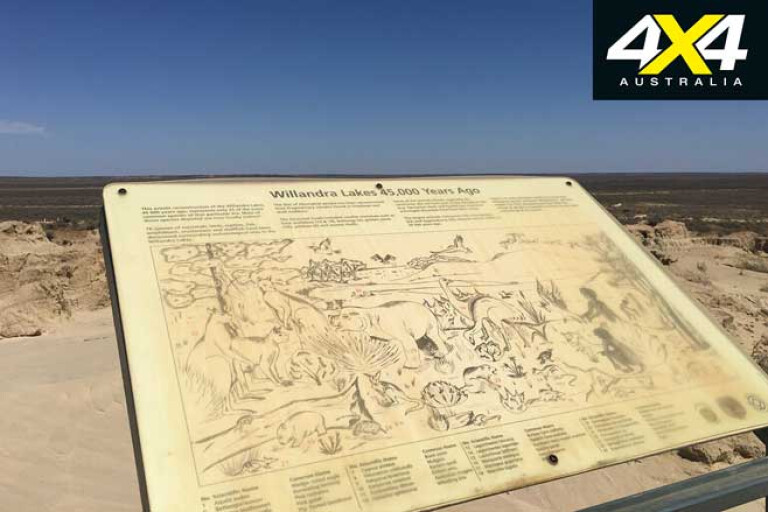
I’m back after my first visit nine years ago and just as enthralled as the first time. It was a wild welcome. Groups of kangaroos, dozens of them, flocked to us as we arrived at Main Camp; large ones, small joeys, a whole family it seemed. There were no other campers, just ’roos. We had the pick of more than 30 sites, most of them had shelter, tables and fire pits. The kangaroos converged, curious yet friendly, as though used to human company.
I was initially unnerved by their boldness, but they seemed thirsty. The landscape was barren and dry and so we gave them a drink from the water tank attached to the shelter. Together with a squadron of apostlebirds they hovered in the background during our stay, in the shade, never bothersome, just there.
We travelled to Mungo after an overnighter at Wentworth, where the mighty Murray and Darling rivers meet. It was an easy drive towards Pooncarie before turning onto Top Hut Road. Here the road became rougher and corrugated, so we let some pressure out of the tyres to make for a better ride.

Entering Mungo territory is like entering another land. Big skies, endless horizon, low-lying mallee shrub and not another vehicle in sight. Driving across the expansive dry lakes feels almost like a time warp. Years of wind, searing sun and droughts have eroded the area of dry lakes, leaving essentially a fossil landscape.
Interestingly our GPS still showed blue lakes, but forget any idea of swimming. Mungo is one of 17 dry lakes that make up the Willandra Lakes World Heritage area and there’s not been a drop of water here in more than 1400 years. Once, however, this lake was full of water and teeming with life. It was a meeting place for generations of Aboriginal people.
Mungo’s History in a Nutshell
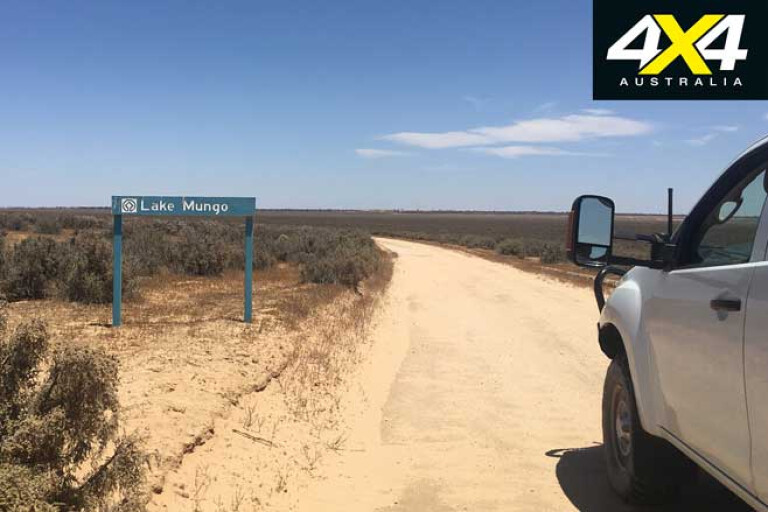
When the lakes dried up about 10,000 years ago the bones and relics of the people who once lived on its shores were swallowed up by the desert sands. Then the wind exposed a fragment of history.
In 1968, a geologist by the name of Jim Bowler found remains of what became known as Mungo Man. Years later he found Mungo Lady. In doing so, Australia effectively became home to the oldest human skeletons ever found including some of the oldest found outside Africa. Over the years it’s been said that Jim Bowler didn’t find Mungo Man and Mungo Lady, but that they found him. “Because they had a story to tell, even after 45,000 years. They wanted to let white Australia know that the Aboriginal people had been here for a long time and were still here.”
Mungo has since become a place of significant archaeological importance, and today the Mungo lunette preserves thousands of snapshots of indigenous life. These discoveries have given scientists clues on how ancient tribes lived and adapted to climate change more than 40,000 years ago.
It’s an extraordinary story of how a culture was able to stay strong and care for country, even as climate change dried up the lakes that were the lifeblood of the region. More discoveries and relics are being unearthed all the time and, understandably, this fragile area is now protected with restricted access. The remains of Mungo Man and Mungo Lady, which were taken away and studied by scientists for decades, will, in 2020, be returned with no fanfare to their resting place in Mungo.
Settling into Mungo time

Once we’d set up the ’van, tents and swag, not to mention the dome ‘dining room tent’ (the flies are friendly here) we settled into camp with a cold drink. Close to camp, Mungo lookout offers one of the most expansive views over the vast dry lakes. A visit here at sunset and at sunrise is awe-inspiring and a reason in itself to stay overnight.
Our first port of call was the Visitor/Interpretative Centre, 2km up the road. This is the hub of Mungo, where you organise camping permits and where most guided tours depart from. There are plenty of interesting displays here including a mega wombat at the entrance. Inside you’ll learn about the rich natural history and cultural importance of Mungo. It’s air-conditioned, a respite from the often-searing heat, and open 24/7. The best part for campers is the very welcome free hot showers.
Don’t miss the shearing shed close by, on what was once Gol Gol Station. It’s a fascinating place with plenty of signs and stories inside depicting the pastoral history of the land. Non-campers can stay in the shearing quarters nearby or at the eco-friendly Mungo Lodge a couple of kilometres away. To me, however, the best way to experience this magical place is by camping beneath the stars.
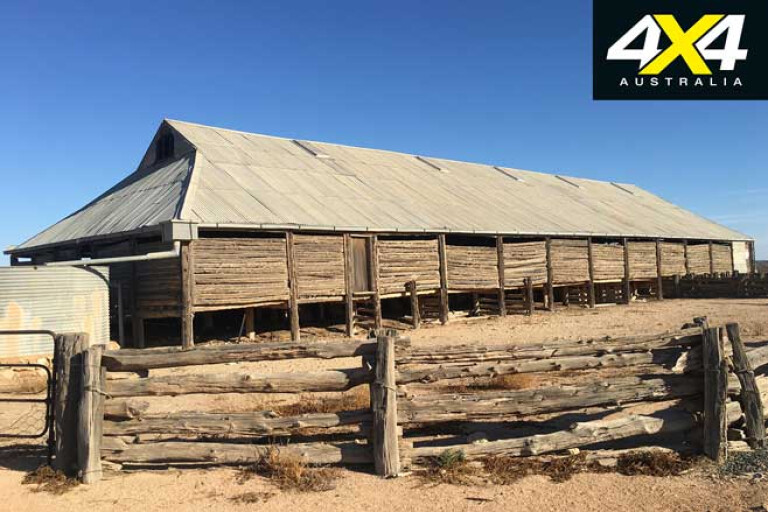
Out on the tracks the next day, the 70km self-guided tour is a great way to explore Mungo territory. You can pick up a copy of Driving the Mungo Story at the Visitor Centre, which gives route notes along the drive, providing a great all-round experience of Mungo. The loop leads across the lake floor to the Walls of China, over the dunes to the mallee country, and then around the north-eastern shore of the lake walls. You can camp at the remote bush campground, Belah Camp, at about the halfway mark. Keep an eye out for emus and wallabies that have zero road sense and often dart out onto the road.
Allow at least half a day for this tour to appreciate the boardwalks, interpretative signs and nature trails, not to mention the impressive dunes at Vigars Well. This was the site of a watering hole for coaches and drays and you can still see the old wagon and dray tracks that cross the lunette. Here, massive sand dunes rise above you and almost beg to be climbed.
From the car park it’s a steep walk to the top, leading to dazzling vast sand as far as the eye can see. Up high you get a sprawling 360-degree view of the lake floor and surrounding plains, and the sand is like pure silk ... and scorching hot on this day. It’s impressive and lots of fun, but make sure you take plenty of water with you.
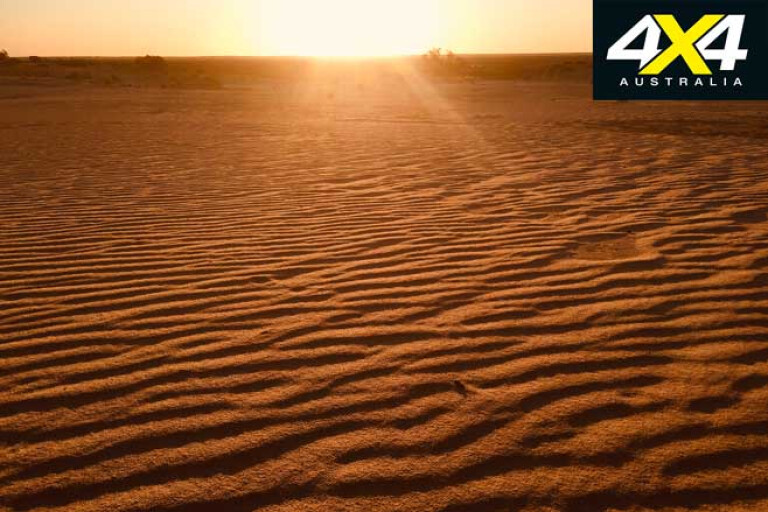
Our sunset tour on the last night was the highlight and culmination of our time at Mungo. There’s no way to get out to the Great Walls of China without a guide. Visitors can walk to a lookout point, but, beyond that, access to the lunettes is only allowed with an accredited guide. Constant decay from wind and rain has created the formations, and only the Aboriginal rangers and guides know where to step.
At almost 35km long and reaching 30m high in parts, we recommend experiencing this landscape for yourself as words don’t do it justice. A walk to the top of the continually drifting sands opens to a magical view across the dry lake floor. During the day it’s impressive, but at sunset, when the sun changes the colours of the landscape from yellow to orange and brilliant deep red, it’s like another world.
Our guide was Gregory, the manager of nearby Mungo Lodge, and he was a wealth of knowledge with his entertaining and informative narrative. It was also his birthday, as we found out from wife Jo before the tour. As we walked across the western shore of the ancient lake bed and climbed the red sand hills, he had us enthralled, bringing the past to life with fascinating stories of early Mungo history.

We walked mindfully amongst the lunettes and rock formations, as Greg pointed out a midden and other recently exposed shells, evidence of a time when this place was full of water. It was mesmerising, being out there, as the light dipped closer to the horizon. At the top of the Walls, as we gathered for photos, we spontaneously broke out in song, surprising our guide with a Mungo-style Happy Birthday rendition.
The last time we were here, more than nine years ago, it had been my birthday. I still remember the text my sister sent me afterwards: “Compared to Mungo woman, you are spring chicken!” Yes, I certainly felt a sense of timelessness here; a real sense of history in a surreal setting.
We drove back to camp under a big sunset that lit the way. In the one day, I had watched the sun rise and the sun set over Mungo. As you stand and gaze over vast dry lakes, imagining this land once 10m deep with water, you realise this is a place that transcends time.
This land of spirituality, archaeology and stories from the past intoxicates as no place I’ve ever been before; it’s a place where you can walk in the ancient footsteps of time and culture.
Travel Planner
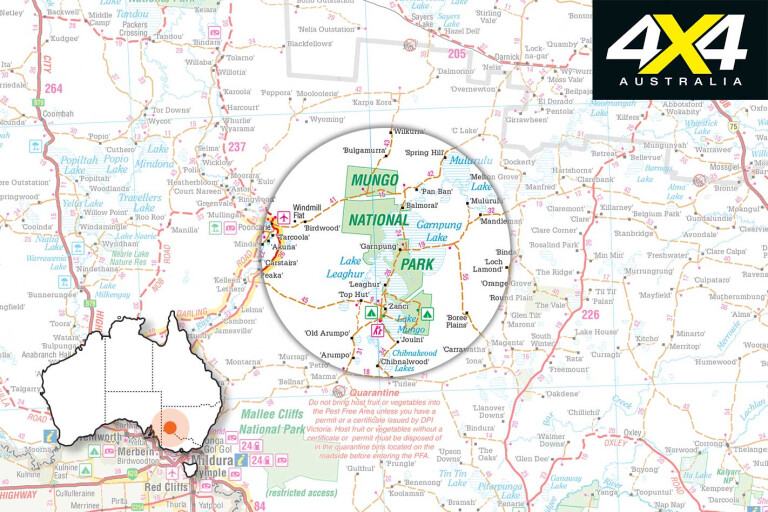
Where
Mungo is approximately 110km north-east of Mildura, along the unsealed Arumpo Road or Top Hut Road if coming from Wentworth. All unsealed roads become impassable after rain.
Camping and permits
Main Camp: 33 sites, pit toilets, fireplaces, gas barbecues, tables and shelter. Camping fees and park entry fees are payable at the nearby unmanned Visitor Centre.
Belah Campground: halfway camp if doing the Mungo self-drive tour, with 12 sites, pit toilets and tables. No fires allowed here.
Supplies and Facilities
The closest town for food and fuel is Pooncarie, 81km away, with supplies, spare parts, fuel, LPG and beer available here.
Contacts and Information
Accommodation and tours are available at Mungo National Park and Mungo Lodge.
For information on Mungo National Park including accommodation, tour bookings and internal road closures and alerts, visit: http://bit.ly/MungoNPNSW

COMMENTS